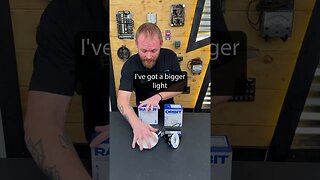What is Voltage Drop? How to Avoid it and Telltale Signs!
At some point or another, as electricians, we are going to have to address the problem of voltage drop. But what is it, what can it do to our equipment, and how can we combat it? In the latest episode of Electrician U, Dustin explains voltage drop and how it works.
🤘⚡️MEMBERSHIP⚡️🤘
JOIN ELECTRICIAN U - become a member and get:
FREE Continuing Education every year
FREE Practice Exams
FREE Monthly Video Courses
FREE Weekly Live Instructor-Led Classes
FREE Monthly Educational Newsletter
Premium Members-Only Content
Private Discord Channel
Monthly Members-Only Discord Chats
Sign up here --- https://www.electricianu.com/electrician-u-membership/
🎧🎹MUSIC AND VIDEO:🎹🎧
https://www.facebook.com/descantmv
🎬✍️ART AND ILLUSTRATION:✍️🎬
https://www.daverussoart.com
First let’s understand how it can work by relating it to water pressure. Think of a water faucet; if you turn DOWN the pressure (or have less pressure to start with), water will flow less as there is less pressure forcing it thru the pipe. Voltage drop works in much the same way! Next, we won’t necessarily REALIZE the issue until we apply a load to the circuit. In other words, we won’t notice we have an issue until we energize the circuit and attempt to have something work (motor, light, heater, etc.). The further we go (the longer the distance), the more voltage we will end up dropping. Also, we will see a bigger issue with voltage drop with smaller conductors. Lastly, there will be less voltage drop effect on a three-phase system than a single-phase system as a three-phase system is more efficient. Not much, but more efficient, nonetheless.
What are some of the effects of voltage drop? Well, the three major types of items we would normally deal with operate a bit differently under voltage drop. Lights may flicker if a ballasted type of light like LED or Fluorescent, they may be much dimmer than they normally would be if incandescent, or they may not operate at all. Heating type loads will tend to not heat up as much as they should, if at all. Motors may heat up too much, burn up, or tend to just struggle to turn.
We don’t want to figure out that we have a problem with voltage drop AFTER everything is installed and finished, so there are some formulas to use to see how much voltage drop we would experience. For single phase- 2 x K x I x D divided by CM. Three phase- 1.732 x K x I x D divided by CM. The difference between single phase and three phase is the efficiency in the system, although not much more! K will be dependent on conductor type. Use 12.9 for COPPER conductors or 21.2 for ALUMINUM conductors. I is the AMPERAGE of what you are attempting to use at the end of the run. D is the distance you are taking the circuit ONE WAY. To figure out what CM (circular mils) is, we need to know what SIZE of wire we are attempting to run. For that, Chapter 9 Table 8 in the NEC is where we would turn. The table shows us the circular mils size for all sizes of wire. So, in essence, after you crunch the number, you will have a BIG number divided by another BIG number! So, at first, it may seem like its too large, but once you divide it by that other large number it will come down! The resulting number after performing the calculation will be the number of volts LOST during that length of run with that size wire.
To combat voltage drop, there are a few things we can do to lessen the effects. You could shorten the run. If outside in the dirt, you could run straight from point A to point B in lieu of following building lines. You could also RAISE the voltage of the system you are putting at the end of the circuit (if possible). So in lieu of 240v maybe see if a 480v system can work. This will give you MORE voltage to lose and may help. You could also INCREASE wire size so you will have a larger conductor, therefore a larger number to divide with (CM). You may also try to see if there is a more efficient (less amperage) piece of equipment as that will result in the number on the top being smaller!
As far as the NEC goes, there are a couple of code articles that address Voltage Drop. Article 210.19(A) informational note 3 for Branch Circuits and 215.2(A) informational note for Feeders. In essence, they both allow 3% for either branch or feeders and no more than 5% for both combined.
We hope this has been helpful in understanding voltage drop and how to combat it! Is there a topic you would like to see discussed? Leave a comment in the comment section and let us know. Please continue to follow Dustin and Electrician U as we are constantly adding new content to help our followers be the best electricians that they can be.
-
 0:50
0:50
Electrician U
5 months agoWhat Are Lumens?
11.6K4 -
 9:39
9:39
Tactical Advisor
1 day agoHow To Improve Your Shooting For FREE! Mantis Blackbeard X
77.8K14 -
 1:00:59
1:00:59
Squaring The Circle w/ Randall Carlson
1 day ago#007 The Real Climate Crisis Noone Is Talking About and Mount Tambora Pt 2
82.7K21 -
 13:52
13:52
America Uncovered
1 day agoEveryone is WRONG About Trump's Guilty Verdict
62.2K102 -
 13:10
13:10
Censored TV
1 day agoThe Owen Benjamin vs Jim Goad debate was WILD
60.9K50 -
 25:27
25:27
Degenerate Plays
21 hours agoThe Microtransaction Master - Call Of Duty Modern Warfare Remastered : Part 3
63.1K4 -
 21:03
21:03
MYLUNCHBREAK CHANNEL PAGE
1 day agoOld World Minnesota?
64.1K36 -
 5:49:05
5:49:05
Akademiks
1 day agoDrake Next Move - Whats next?? Did Lil Baby Listen to Me? Diddy and Family Preparing for Indictment?
122K57 -
 1:56:06
1:56:06
TimcastIRL
1 day agoTrump Raises RECORD $52.8 MILLION In One Day, Bonus Uncensored Show w/Laura Loomer | Timcast IRL
140K527 -
 23:19
23:19
Scammer Payback
5 days agoWe Created the First Ever 𝗔𝗡𝗧𝗜-𝗦𝗖𝗔𝗠 Call Center
234K273